Let’s face it, when it comes to Google, as a local business, how you show up in the map results can oftentimes be the difference between thriving or just getting by. With over 60% of Internet traffic being from mobile devices nowadays, the map results only continue to be a more integral part of your client’s online success.
Working through your local SEO checklist takes time, and even then the results usually aren’t instant. In the meantime, you’ll still want a way to rank at the top of the map results, because who wouldn’t? If that’s the case, you can use Google’s Local Search Ads to advertise your client’s business on Google Maps with Promoted Pins.
What are Google Maps ads?
Google Maps ads, also known as Local Search Ads, are a type of pay-per-click (PPC) advertising that allows you to promote your client’s Google Business Listing at the top of the map search results.
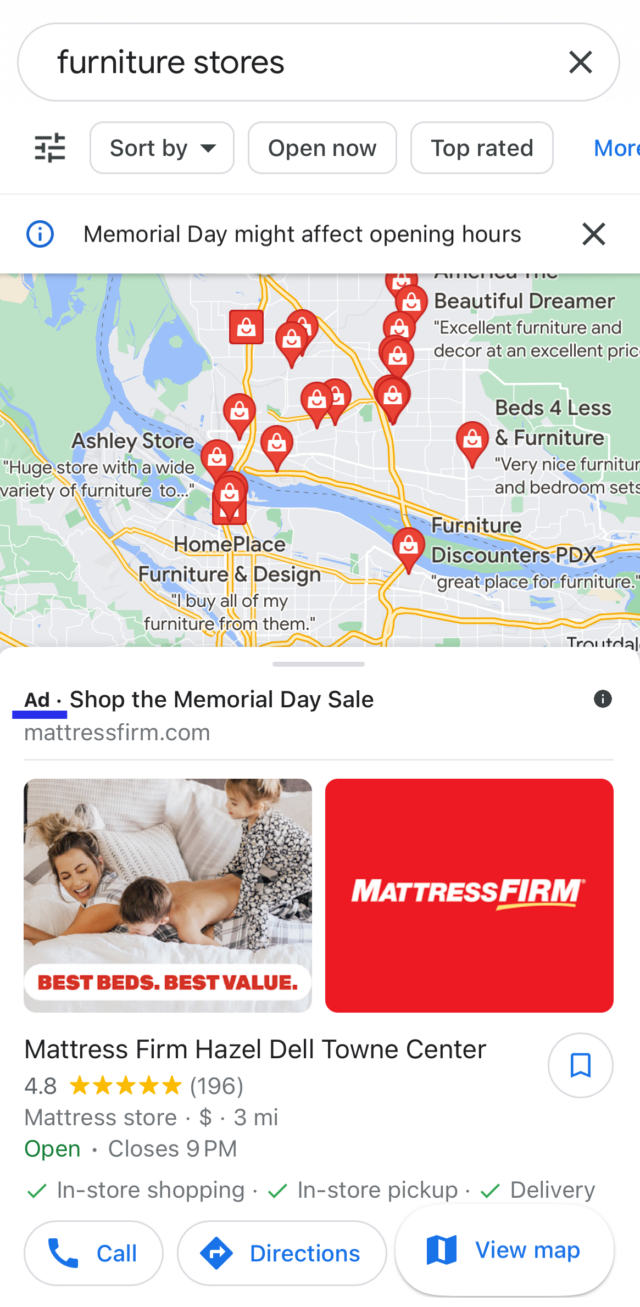
What are the benefits of Google Maps ads?
- Drive more foot traffic to your store. With local search ads, you can make sure you are showing up for people looking for your products and services near your location.
- Get phone calls and leads. Maps ads also include the option for users to call your client’s business by displaying the phone number of the featured business location.
- Showcase your business at the top of the results. Help customers learn more about your business by showcasing your Google Business Profile, which includes information such as reviews, photos, store address and hours of operation.
How do Google Maps ads work?
Showing up at the top of the map results is easy with Google Maps ads. Once you create your ad campaign, your local search ad can show up in three places: mobile search results, the Google Maps app, or in the Maps section on desktop devices.
How much do Google Maps ads cost?
Google charges a standard cost-per-click (CPC) for promoting your client’s GBP on Google Maps with local search ads. Here is the type of clicks Google charges for:
- Get location detail clicks
- Get direction clicks
- Mobile clicks-to-call clicks
- Website clicks
Types of Google Maps Ads
The way your ad shows on the map results can vary depending on the device, the search engine and/or app they use, and the user’s location. Here we’ll highlight how a search query can deliver different results across devices and the Google Maps app.
Here is an example of how ads appear while searching within the Google Maps app on a mobile device:
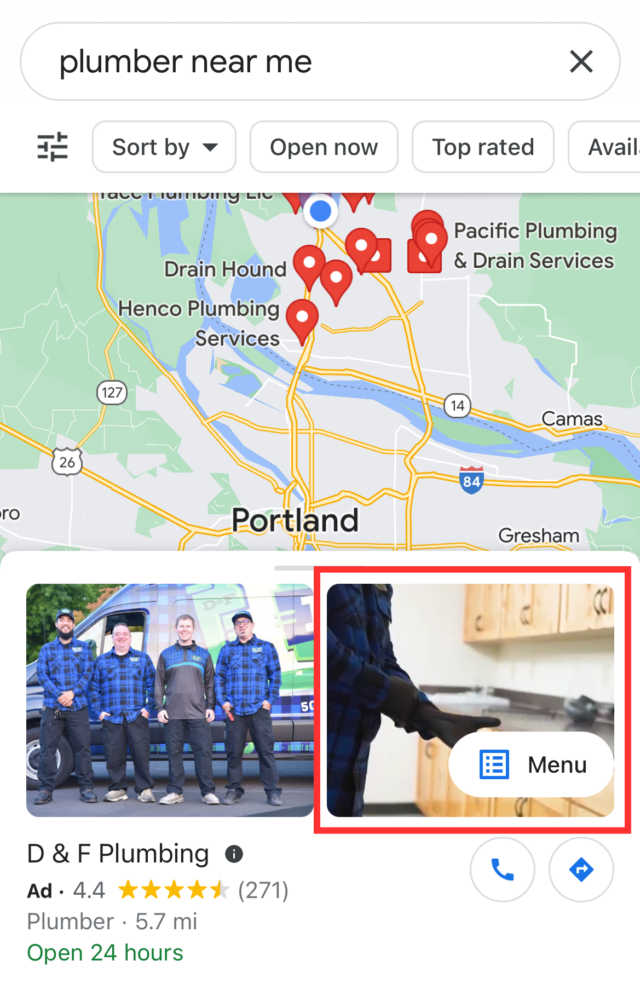
While you can’t tell from the screenshot, the circled boxes are actually videos that were shown in the ad. This content is being pulled directly from the client’s Google Business Profile.
Think adding images and videos to GBPs is important? Well now you have another advantage to add to the mix, they help improve your ad performance!
How it appears in the maps results while on desktop:
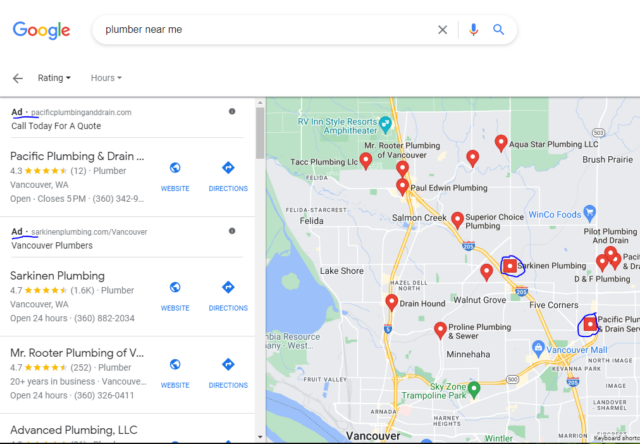
Here is an example of what happens when a user clicks on one of the ads:
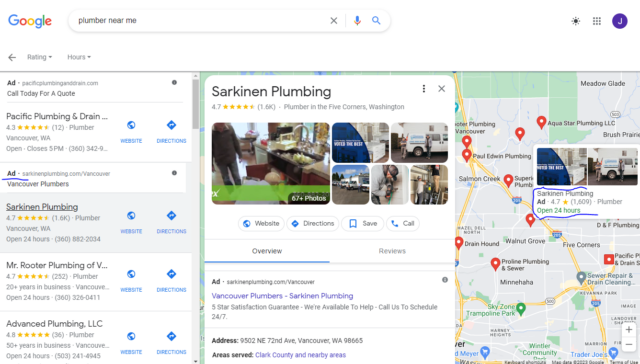
As you can see from the screenshot above, the ad works in conjunction with your client’s Google Business Profile, further stressing the importance of having an optimized Google Business Profile that helps capture a user’s attention.
Here is an example of the search results on mobile:
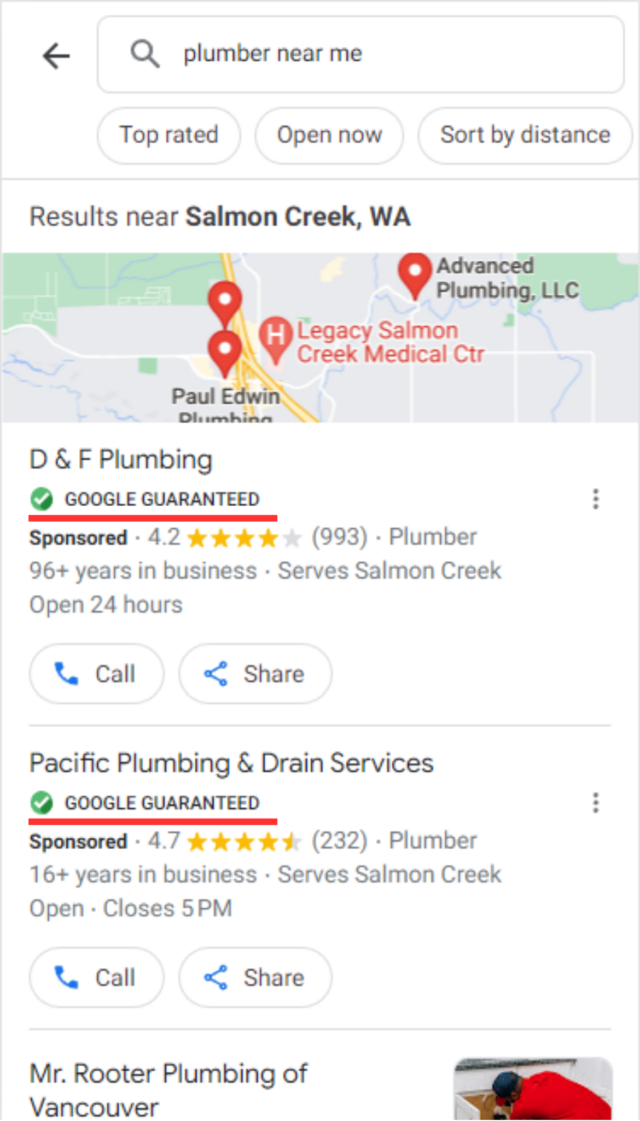
You’ve probably already noticed this by now, but Google has also been experimenting with serving Google Guaranteed Ads (Local Services Ads) in the map results. The example above shows this.
As Google continues to expand Local Service Ads, we should expect this trend to continue with the Google Guaranteed Ad units winning more of these placements.
Recommendation: Don’t be afraid to also explore LSAs if your clients aren’t trying them already. As an added advantage, LSA tends to produce lower lead costs than what you see with traditional PPC ads.
Features of Google Maps Ads
There are a number of different features in Google Maps Ads, like promoted pins and featuring specific reviews by customers.
What are promoted pins?
Promoted pins are a paid advertising feature on Google Maps. They allow businesses to appear at the top of the search results for a specific keyword or location. Promoted pins are a great way to increase brand awareness and drive traffic to your website or store.

How do promoted pins work?
When someone searches for a keyword or location on Google Maps, promoted pins will appear at the top of the search results. Promoted pins are marked with a red square pin and include the business name, address, phone number, and website. When someone clicks on a promoted pin, they will be taken to a landing page with more information about the business.
Featured Customer Reviews
Reviews matter and having a strong rating with a healthy number of reviews can greatly impact the performance and success of your ads. They are one of the main pieces Google uses when displaying businesses locally in the search and map results. Think back to the last time you purchased a product or service, if you are like 76% of consumers, chances are you probably read the online reviews and those reviews impacted your decision on which brand or company to purchase from.
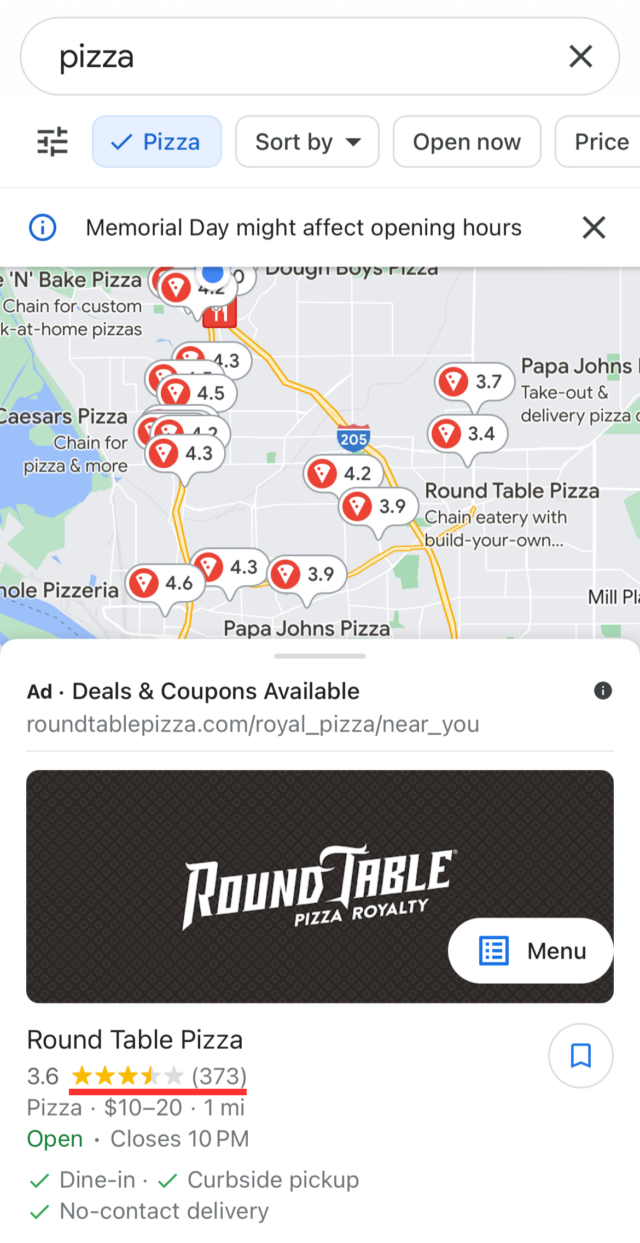
Here is an interesting example of where Google is showcasing GBP reviews in the map pins. This further highlights the importance of reviews and how having a solid process in place for your client’s reputation management is an important ingredient to their online success.
As a rule of thumb, I like to tell clients that they should have at least 25 to 50 reviews before considering testing Google Local Search Ads.
When a user clicks on a promoted pin in the map results, they can see the review summary, read highlighted reviews, and get an overall sense of your client’s business.

Build a 5-star Reputation
Collect, monitor, and respond to reviews with ease
In-Store Promotions
Do your clients ever run any promotions or special offers? By using promotion assets or utilizing Promotions in Google Merchant Center, you can incentivize people to be more likely to choose your products or services when searching nearby on Google.
Here is an example of a local Best Buy running a Memorial Day sale and their promotion being displayed in the ‘in-store’ results:
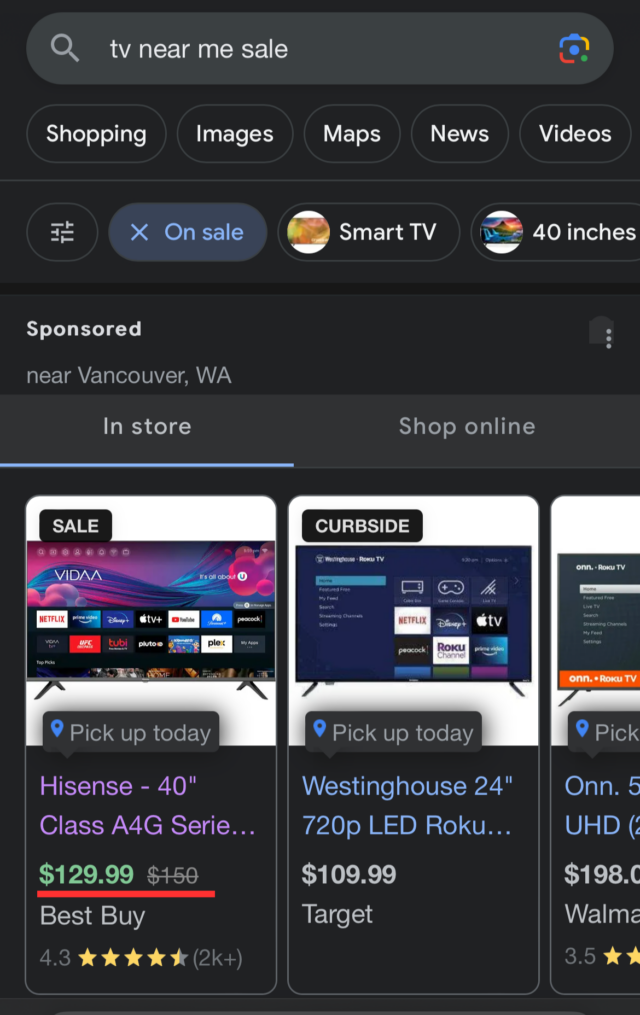
Local Inventory Search
In a world of instant gratification, having the ability to showcase your client’s products at the top of the ‘in-store’ results can be a nice way to boost sales and increase foot traffic. Local inventory ads are a feature that allows you to showcase your client’s products and store information for shoppers searching nearby.
Local inventory ads are available by adding your client’s products to their Google Business Profile or uploading them in mass to Google Merchant Center to then sync with the GBP. Here is a guide from Google to get started.
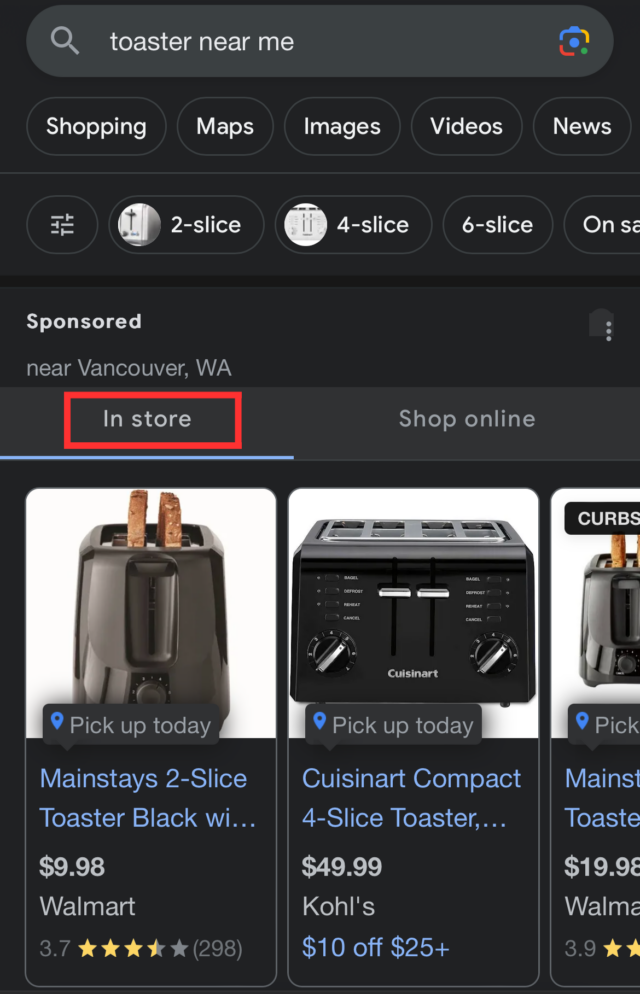
Here are the core benefits Google highlights with Local Inventory Ads:
-
- Promote your in-store inventory. Let shoppers see that you have the products they’re looking for, at the moment they are searching.
- Bring your local store online. Provide users with a robust, digital storefront experience by leveraging Google’s merchant-hosted local storefront feature.
- Highlight your store pickup options directly on your local inventory ads.
-
- Pickup today feature
- Pickup later for local inventory ads
- Pickup later for shopping ads
- Measure performance. You can monitor the impact of your ads by tracking online and in-store performance.
How To Advertise on Google Maps with Google Local Search Ads
Google Local Search Ads are a type of online advertising that allows businesses to appear at the top of the search results in their desired areas. These ads are shown when someone searches for a business, service or product on Google Maps or Google Search, and they include the business’s name, address, phone number, and website.
Here Are The Steps:
Step 1: Set up and optimize your Google Business Profile
First and foremost, does your client have a GBP and is it optimized? Make sure that the Google Business Profile is synced with the ad account and is optimized to look compelling to potential leads.
Important note: GBPs set as service area businesses are not eligible to serve as a promoted pin in the map results, there needs to be an actual address publicly visible on the listing.
How To Sync Your GBP With Google Ads:
- In the ad account, you will look for Assets which is under Ads and Assets.
- Click the blue plus sign button “create asset”.
- Then click the Location Assets to follow the steps to sync your GBP.
Manage multiple businesses from one ad account
You can link multiple business profiles to an ad account. If you have multiple GBP profiles under your manager account, make sure to use the filter feature to segment out the desired GBP profile(s); otherwise, you run the risk of your other client’s business profiles accidentally showing in your ads.
Step 2: Create a Google Ads campaign
- Go to the Google Ads website and sign in to your account.
- Click on the “Campaigns” tab.
- Click on the “New campaign” button.
- Select a campaign objective based on your client’s goals: Sales, Leads, or Local Store Visits
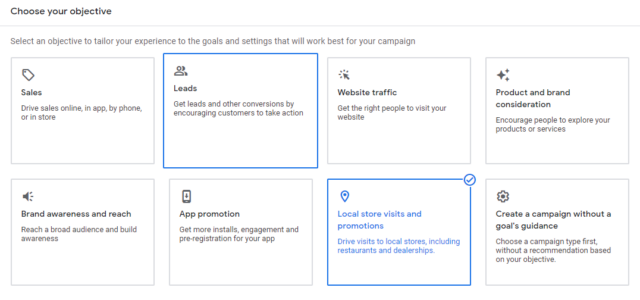
- Choose from the available campaign types:
- Performance Max Campaigns.
- Search Campaigns.
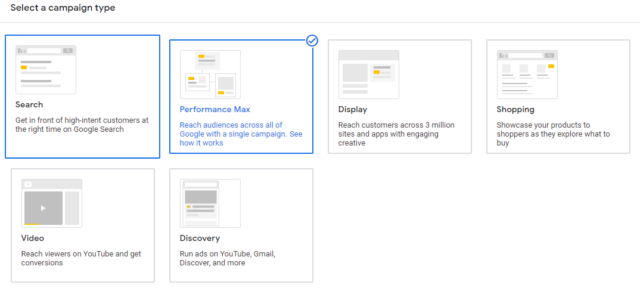
- Follow the prompts after selecting your campaign type. This part of the process will guide you through setting up your budget, targeting and ad copy.
- Once you complete the initial campaign creation process, go back and make sure you are utilizing all relevant ad extensions. For instance, make sure under Location Assets, that you have the client’s GBP synced with the ad account and campaign(s).
Choosing Between Campaign Types
Search Campaigns
Google’s OG ad unit, the standard text ads most people are familiar with when it comes to Google Ads. I like this campaign type because it allows you to get as granular and specific as you’d like with your keyword targeting. Want to show up for a specific set of terms, in a specific area? Search ads with exact-match keywords make for the perfect solution. Want to also add some audience targeting, like narrowing your targeting to people in the higher income brackets? Search ads allow you to do that and more.
Performance Max Campaigns
Google’s latest campaign type combines the available ad units to reach audiences across all of Google with a single campaign. Performance Max campaigns, once properly set up, tend to require less bandwidth post-launch to further optimize their performance. The key things to keep in mind with Performance Max:
Take advantage of all available ad extensions, headlines and descriptions.
- If your client has good video creative on YouTube, I suggest using that.
- Make sure that you also add images, if the client doesn’t have any creative handy, Google can scan the client’s website or will provide you with stock imagery to choose from.
Conversion tracking is crucial to the success of a Performance Max campaign. The mindset behind this campaign type is that you are letting Google’s system leverage its various data and touch points to determine and identify your target audience to serve ads to. Don’t skip this step, with solid conversion tracking, you are providing Google’s system with clean data to optimize around
Give your campaign a headstart by building an audience signal. Remember that keyword research you did, this becomes a great tool by creating a custom audience segment and using those keywords to target people who are actively searching for your keywords or are showing that search intent.
Tips for Getting Your Ads to Show More Frequently in the Map Results
- Make sure the Google Business Profile listing is complete and accurate.
- Use relevant keywords in your listing.
- Write compelling ad copy that will make people want to click on your ad.
- Utilize all relevant ad extensions to add more information to your ad, such as your phone number, address, and website.
- Track your results by setting up conversion tracking and make adjustments to your campaign as needed.
Advanced Tips and Tricks:
- Utilize bid adjustments for device types. To win the map ad placement, you have to have a competitive enough bid to secure a placement that is at the top of the search results. Since a lot of map traffic is from mobile devices, adding a bid adjustment to bid more for mobile devices is a way to try and show up more on the maps without having to get overly aggressive with your keyword bids.
- The advanced bid adjustment is another feature that helps your ads rank higher in the search results, it is a bid adjustment geared towards helping you win the call extension placement. Since the map ad results feature the business’s phone number, this can be another method used to tweak your campaign to focus more on showing up in the map results.
Common Mistakes and Pitfalls To Avoid
When it comes to Google Ads, SEO and marketing in general, testing is key as there are a lot of approaches you can take. With that said, here are some ideas to keep in mind:
Make Sure You Set Up Conversion Tracking
- Google is a data-orientated company and its algorithm thrives on data. Taking that concept to heart, you should make sure that you are properly feeding your lead data back into Google. When you feed accurate data to the ad platform, then the system can better optimize towards your desired goals: produce more leads or sales for your clients.
- Conversion tracking can be set up in a number of ways:
- Use GA/GA4 to track the user journey on your client’s site
- Create Google Ads pixels and install them on your client’s site.
- Use a lead/call tracking platform like CallRail, which can do a lot of the technical work for you and provide clear insights into the leads your client gets by tracking across their various marketing channels. It also integrates with a number of platforms, like Google Ads and Google Business Profiles, Facebook, WordPress, Zapier, etc.
Keyword Targeting and Keyword Match Types:
One of the most common mistakes I see people make with Google Ads is that they take too broad of an approach with their targeting. As the saying goes, the devil is in the details. Here are some common things to look out for:
- When it comes to Search campaigns, keyword match types are important. Avoid starting out with the broad match type, it can lead to wasted spend if you don’t have a solid negative keyword list already. Broad match should be considered once your campaign is already producing consistent results and you are looking for additional opportunities you may have not already considered/been targeting. I suggest starting with exact match or phrase match.
- For keyword targeting, you will get the best results by focusing on the keywords and traffic that have ‘buying intent’. Also, it helps to target your client’s products and services that have the best margins or generate the greater revenue and returns. Try to put yourself in the shoes of the consumer. As digital marketers, it is easy for us to default to industry lingo, whereas the average consumer will be thinking in terms of problems and solutions.
For example, you have a roofer client and they want leads for people who need a new roof. I wouldn’t normally advise making assumptions, but it would be safe to say that the average consumer probably doesn’t know much about roofs and the roofing industry. As a consumer, would I know I need a new roof or would I start with the hope that I just need repairs? What if I go a step further by simplifying my search for just a roofer? The point is, people are more likely to search for the ‘root’ or common terminology since they know there is an issue with their roof and a roofer is the appropriate person to inquire with.
How to Incorporate Google Ads to Support Your SEO Efforts
I’ve always said the key to success for local businesses on Google comes down to three main components: reviews, SEO, and Google Ads. Reviews are the lifeblood of your client’s business and help supplement their organic rankings and improve the conversion rates of their paid ads.
We all know with SEO, when done correctly, provides tremendous value for local businesses; however, just like any worthwhile endeavor in life, there are no shortcuts to instant overnight success, unless you win the lottery, but we’re not counting on luck here. Improving a client’s organic rankings takes time and patience on behalf of your client to wait three to six months to start experiencing the impact of your work.
In a world of instant gratification, this is where Google Ads becomes a great compliment to the SEO services you are offering to your clients.
Google Map Ads can be a great tool for getting your client’s business noticed by potential customers. You can use it to target high-value keywords and directly in the desired locations that your clients want to show up in. Even with a couple of hundred dollars in ad spend, you can boost your client’s visibility and start getting leads right away while waiting for the results of your SEO efforts to kick in.
Conclusion
By harnessing the power of Google Ads and promoted pins, businesses can significantly improve their visibility in Google Maps’ map results. Remember to optimize Google Business Profiles, create effective campaigns, utilize ad extensions, and track conversions for optimal results. Combining Google Ads with local SEO efforts provides a comprehensive strategy to maximize online success for local businesses.





